#Tasting history with max miller
Explore tagged Tumblr posts
Text


ORIGINAL TOLL HOUSE CHOCOLATE CHIP COOKIES (1938)
Since I won't be home for the holidays this Christmas (we are going to Australia to spend a summery Christmas with my in-laws), I went home to Canada a little early for a quick trip - most importantly to meet my new, adorable niece! Surrounded by childhood favourites and nostalgia, I thought it would be a great idea to make a classic Tasting History treat with my mom: the Original Toll House Chocolate Chip Cookies. This first ever chocolate chip cookie recipe, originally called Chocolate Crunch Cookies (a later newspaper typo created its now-common name), was created by Ruth Wakefield and her head pastry chef Sue Brides at The Toll House Inn in Whittman, MA in 1938. The restaurant was already quite popular among locals and food critics, and Ruth finally decided to share the recipe for these star cookies with the public. It was printed in newspapers, and the popularity of the chocolate chip cookie grew even further when Nestlé printed it on the back of their packaging. In the original recipe, Nestlé's chocolate is mentioned by name, and the growing popularity of the cookie recipe led to a 500% increase in profits for the company. Their chocolate bars originally had to be chopped up into 'pea-sized' pieces by hand until Nestlé began selling scored bars with the correct size, and eventually chocolate chips - created especially for making chocolate chip cookies. Interestingly enough, the original chocolate chip cookie recipe is very close to the one that is still on packages today. I have very fond memories of making chocolate chip cookies with my mother as I was growing up, and I thought, what better way to compare the two recipes than to also make this original chocolate chip cookie recipe with her! See Max’s video on how to make this dish here or see the ingredients and process at the end of this post, sourced from his website.
My experience making it:
Finally in my natural element in Canada, with easier to find ingredients that I recognized and could more predictably bake with, I was able to follow the recipe exactly. The one major change I made was to omit the chopped nuts completely, mostly because I'm not a fan of nuts in baked goods.
Because this recipe requires an overnight element, my mom and I began preparing the cookie dough the day before we wanted to bake and eat them. My mom began by beating the eggs, then creaming the butter with a hand mixer while I portioned out the other ingredients. She added in the sugars, eggs, baking soda dissolved in water, and vanilla and mixed them until combined. I then slowly sprinkled in the flour and salt mixture into the mixing bowl while she mixed, until that, too, was combined. I was worried the dough was looking a little too dry and dense, but my mom assured me it still looked right - I totally trust her baking instincts! We then folded the chocolate chips into the dough with a spatula, then covered it with Saran wrap and let it sit in the fridge overnight. The next evening, we preheated the oven, took our dough out (which had really hardened up!), and began portioning it out into little balls of dough. My mom had to use a fork and a bit of force to portion it, since it was so cold and solid! We used a weigh scale to determine the 14 oz. size of ball, but honestly, we did end up going up to 20 oz. or so at some points - it would have taken a long time to weigh every ball. On a lined baking sheet, we fit about 14 balls of dough, spaced about 2 inches apart. After pressing down on each just a little bit, we tossed the first batch in the oven. It smelled so good, and the bits of raw cookie dough I snuck while waiting for the cookies to bake were heavenly! When we took them out, we transferred them onto cooling racks. I think we baked about 5 trays of cookies overall, leaving us with an absolute plethora of chocolate chip cookies by the end! They looked small, but classic - almost like the chocolate chip cookies you can buy in a store. Very photogenic, in my opinion.
My experience tasting it:
Of course, our patience got the best of us, and we did not wait for the cookies to cool before trying them. No regrets! They tasted wonderful - crisp on the bottom and edges, but soft and a little melty in the middle. Really ideal, this kind of cookie could please everyone. My mom likes her cookies on the crispier side, and I like mine on the soft and gooey side, yet we both were very happy with how this recipe turned out. So was my dad, sister, my brother-in-law, and my aunt! In fact, these cookies didn't taste much different from my mom's chocolate chip cookie recipe (as I remembered it). She claims she also got her recipe from a newspaper, so it may have also had the same origin as this one. The flavour of these cookies was sweet, but balanced by the salt and rich brown sugar. They were so tasty, I think this could even become my main chocolate chip cookie recipe, although I will probably make each cookie even bigger in order to get a large volume of soft gooeyness. And I will definitely halve the recipe! 100 cookies or so, as tasty as they are, is an awful lot to get through and would definitely become noticeable on the waist. Otherwise, I agree with Max that there is a reason this recipe has lasted so many decades in its nearly-original form - it really is a crowd-pleaser. I was happy I was able to take some cookies with me back to Germany so I can share some with my husband! If you end up making this dish, if you liked it, or if you changed anything from the original recipe, do let me know!
Original Toll House Chocolate Chip Cookies original recipe (1938)
Sourced from Ruth Wakefield’s Toll House Tried and True Recipes by Ruth Wakefield (1938).
Toll House Chocolate Crunch Cookies Cream 1 cup butter, add 3/4 cup brown sugar, 3/4 cup granulated sugar, and 2 eggs beaten whole. Dissolve 1 tsp soda in 1 tsp hot water, and mix alternately with 2 1/4 cups flour sifted with 1 tsp salt. Lastly add 1 cup chopped nuts and 2 bars (7 oz.) Nestle’s yellow label chocolate, semi-sweet, which has been cut in pieces the size of a pea. Flavor with 1 tsp. vanilla and drop half teaspoons on a greased cookie sheet. Bake 10 to 12 minutes in 375° oven. Makes 100 cookies.
Modern Recipe
Based on the recipe from Ruth Wakefield’s Toll House Tried and True Recipes by Ruth Wakefield (1938) and Max Miller’s version in his Tasting History video.
Ingredients:
1 cup butter
3/4 cup brown sugar
3/4 cup granulated sugar
2 beaten eggs
1 tsp baking soda, dissolved in 1 tsp hot water
1 tsp vanilla
2 1/4 cups flour
1 tsp salt
1 cup chopped nuts
14 oz. chocolate chips
Method:
Cream the butter until smooth. Mix in the brown sugar, granulated sugar, eggs, baking soda water, and vanilla until combined.
Whisk together the flour and salt. Add this to the butter mixture and mix until just combined.
Stir in the nuts and chocolate chips just until evenly distributed.
Cover and chill the dough overnight.
Preheat the oven to 375°F (190° C).
Scoop dough into balls, about 14 grams each. A half a teaspoon is way too small of a measurement, so I found weighing the dough to be the best way. Place them on lined baking sheets, leaving about 2 inches between each cookie. Press the cookie dough down a bit.
Bake for about 8 minutes, or until golden brown.
Take them out of the oven and let them cool on the baking sheet for 5 minutes, then transfer to a wire rack to cool completely.
Serve them forth!
#max miller#tasting history#tasting history with max miller#cooking#keepers#historical cooking#20th century#baking#cookies#desserts#1930s#Toll House Chocolate Chip Cookies#american recipes#americas#usa#vegetarian recipes#chocolate#massachusetts#chocolate chip cookies#Ruth Wakefield#Ruth Wakefield's Toll House Tried and True Recipes#snacks
206 notes
·
View notes
Text
Potato Crisps / Chips on Tasting History
So we've just watched Max's latest...
youtube
...and I was grinning a bit because I posted about Dr Kitchiner's 1817 (non-US, definitely non-Saratoga) crisps / chips recipe a month ago.
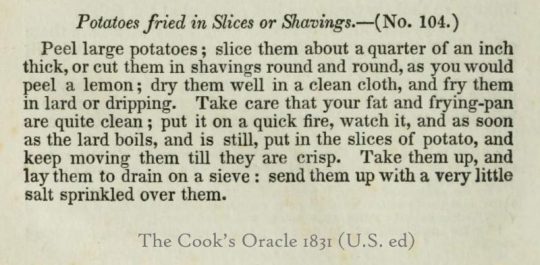
That image was from an American edition of his book; I've found a pic from the original - NB that these slices are floured before frying.
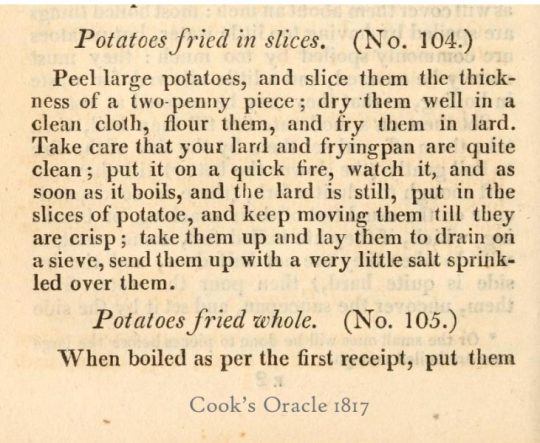
For reference, here's a two-penny piece from about 1797; the coin would still be current 20 years later:
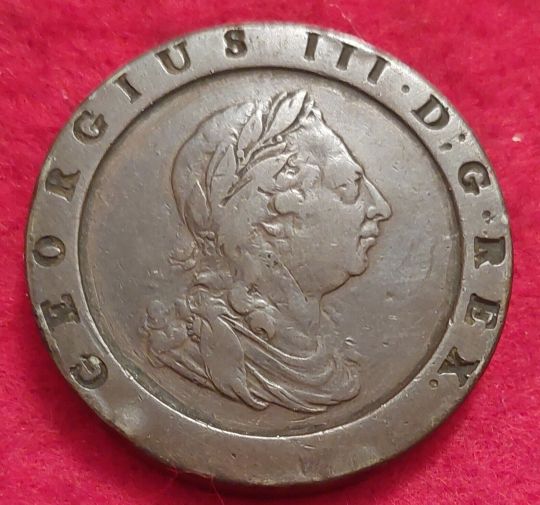

...and here's how thick the potatoes should be sliced. That's 4mm, which is 2mm less than "a quarter of an inch" (6.25mm).
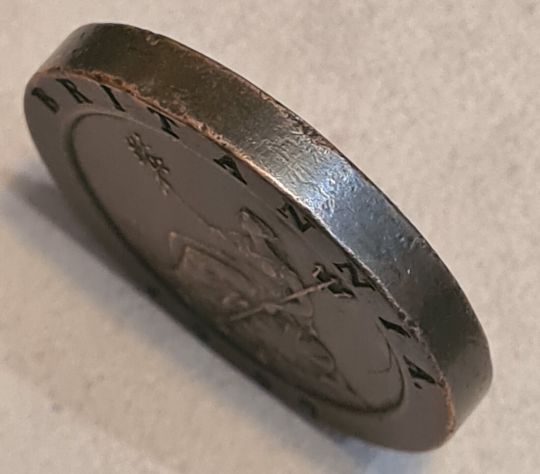
The slices will get even thinner as their moisture evaporates during frying, and, given the nature of recipes, potatoes cooked this way are probably even older than 1817 and Kitchiner's is just the first appearance found so far in print.
*****
The first recipe for "Game Chips" (an accompaniment to grouse, pheasant etc.) appeared, per the Wikipedia link, in a 1903 book published by famous chef Auguste Escoffier (1846-1935):

"Chip potatoes - these are potatoes cut into thin slices; this is usually done with a special plane. (A mandoline.) They are put in cold water for 10 minutes; then drained, dried in a cloth and fried until very crunchy. They are served hot or cold and generally accompany game roasted in the English style."
However, per Escoffier's Wikipedia page, much of his work was based on that of Anton Carême (1783-1833), whose dates are squarely coincident with Dr Kitchiner's Potato Slices.
Given the amount of cookery to-and-fro between England and France after the Napoleonic wars were over, it's impossible to say who first came up with the idea of potato crisps.
The French loved dainties - "un petit quelquechose", a little something - which the English pronounced and dismissed as "kickshaws", something over-fussy yet insubstantial. Yet those same English also loved roasting things with their appropriate accompaniments.
(I'm writing this just over a week after Christmas, and have been well reminded that the phrase "Roast (turkey / goose / beef) With All The Trimmings" is still in common 21st-century use.)
If those roasted things were game birds, only those above a certain level in society would be eating them, so it's not unreasonable to assume a rich-person game bird would attract fussy, time-consuming rich-person trimmings like, okay, Game Chips.
One thing's for sure, Potato Crisps - and Game Chips too, so hard luck, Escoffier - are almost certainly older than even Tasting History could prove.
*****
BTW, they also existed at a time when "English Food Was Bland" is more fake history.
Sauces put out on the table in fancy bottles had fancy labels ("bottle tickets") showing what was in them, and the contents were often far from bland.
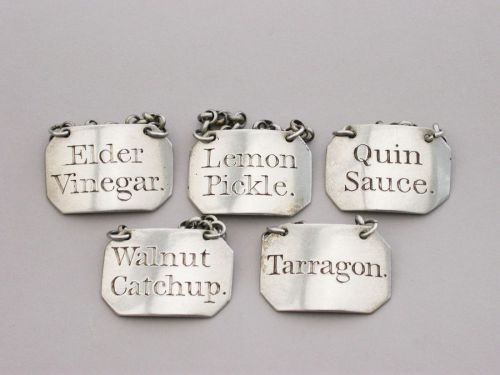
Quin sauce was anchovy-based, hot and pungent.

Harvey's was a spicy sauce similar to Worcestershire, ketchup was probably mushroom and also spicy; the other two need no elaboration.

AFAIK the two crescent-shaped ones in the next pics are deliberate imitations of an officer's rank-gorget.
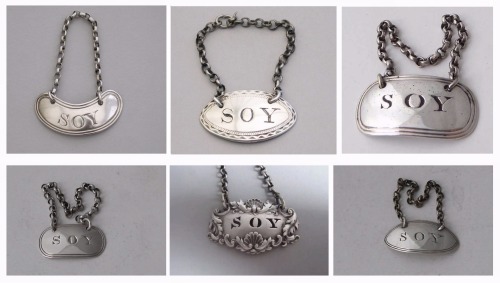


Finally a generic Not-Bland label that would go on any number of modern bottles (antique silver, yours for £250)...
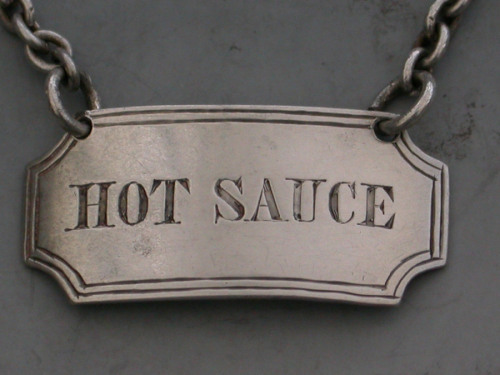
*****
And after all of the above, I could do Very Bad Things to a packet of Tayto Cheese 'n' Onion. A packet?
Why stop at a packet when A Pack takes less time to say?

After all, It Is Written that:
"Reading One Book Is Like Eating One Potato Crisp Chip."
And also that Nothing Exceeds Like Excess...
#food and drink#potato crisps#game chips#Tasting History with Max Miller#Diane Duane#Reading one book is like...#...like eating one potato chip#wise words maxims and apothegms#Youtube
608 notes
·
View notes
Text



Marks and Rec: Misc #2554
"We're going to sh*t on your shingles!" (Dialogue from The Great.)
#max miller#tasting history#dylan hollis#b dylan hollis#incorrect quotes#tasting history with max miller#marks and rec misc#source: the great#vid: chipped beef - b dylan hollis#vid: what did wwii soldiers eat? - tasting history#the food is nicknamed 'shit on a shingle' you see#food image#swearing
327 notes
·
View notes
Note
If Laios lived amongst us would he watch Tasting History with Max Miller? There are some pretty wild ingredients on that show. Are there any other food shows he may like?
22 notes
·
View notes
Text
Hm…




Arceus “Sitting Cuties” Pokémon plushie
#tasting history#tasting history with max miller#mesopotamia#pokemon#pokémon#arceus#sitting cuties#pokemon plush#i’m dead sure someone has noticed this before me but still#ford speaks
53 notes
·
View notes
Text
Tasting History with Nicolo
I’m watching Tasting History With Max Miller and I’m just imagining a TOG au where Nicky hosts a similar show. Joe would film, edit, and help taste test. The rest of the gang would be like guest stars or judges. Like Andy on any desert episode. Quynh helping with East Asian dishes here and there. Booker helping with research and liquor episodes. Nile helping with whatever sounds palatable when she’s not going to school cuz she’s a college kid down for free food
#tasting history#tasting history with max miller#the old guard#nicolo di genova#the old guard movie#tog#yusuf al kaysani#andromache the scythian#joe x nicky#Booker#sebastien le livre#quynh the old guard#quynh#nile freeman
24 notes
·
View notes
Text

link: https://www.youtube.com/@TastingHistory
subject matter: history + cooking
16 notes
·
View notes
Text
youtube
Everlasting Syllabub
MODERN RECIPE INGREDIENTS
1 1/4 pint (590ml) heavy cream (or double cream)
1/4 pint (120ml) of a medium sweet wine (white port, sherry, etc)
The Juice of 1 orange
The Zest of 1 large lemon (or 2 small)
1/2 pound (227g) powdered sugar
1 tsp orange blossom water
METHOD 1. Mix the cream and sugar together in a large bowl until sugar is dissolved. 2. Whisk in the remaining ingredients. 3. Whisk either by hand for 30 minutes or with an electric mixer until you form stiff peaks. 4. Serve or refrigerate for up to 3 days.
#youtube#recipes#recipe#Everlasting Syllabub#dessert#historical recipes#Tasting History with Max Miller
12 notes
·
View notes
Text
If not for covid, the cost of food these days, and my medical dietary restrictions I would host a pot luck were we all make old timey recipes
#why yes i watch too much#tasting history with max miller#b dylan hollis#townsends#great depression cooking#and such#food#cooking#old timey recipes
123 notes
·
View notes
Text
so I was going through Tasting History with Max Miller
(quality content, pls go and subscribe, my little food-archaeology-loving heart adores that channel)
and today I got around to watching the borshch (/borsch/borscht/barszcz) video, which means that TIL that the Soviet Union put out a book in the 30s called
The Book About Tasty and Healthy Food. To the Soviet Housewife from the People's Commisariat of the Food Industry
and that apparently everyone just called it
The Book
which is both way more culinarily ominous and somehow therefore infinitely more stereotypically Slavic.
Like.
They didn't shorten it to The Book About Tasty and Healthy Food, or call it The Cookbook or something
no, they called it The Book.
110% The Book About Tasty and Healthy Food. To the Soviet Housewife from the People's Commisariat of the Food Industry is a regular cookbook with a boring cover and neatly printed recipes
but The Book is 120% some kind of cursed leather-bound grimoire stained with unrecognizable ingredients from magical concoctions and written in the spiky dramatic scrawl of a long-dead slightly-mad wise woman
Yanno?
"We're having borshch tonight - bring me...The Book About Tasty and Healthy Food. To the Soviet Housewife from the People's Commisariat of the Food Industry" is an insane thing to say, for sure.
But somehow
"We're having borshch tonight - bring me...The Book" is both more sensible and more threatening at the same time
and I think that's beautiful
unrelated but that video also made me cry so thanks for that Mr. Max Miller
#olivesoriginals#tasting history#tasting history with max miller#jestemoliwki#maybe?#not about poland but yanno
10 notes
·
View notes
Note
Tasting history with Max Miller!
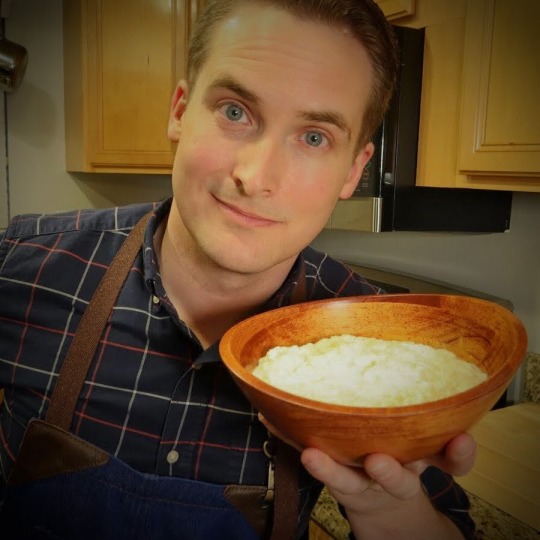
15 notes
·
View notes
Text


TEMPLAR BOAR WITH CAMELINE SAUCE (14th c.)
This past Thursday, the Corpus Christi public holiday in my part of Germany, known here as Fronleichnam, gave me a little extra time to make another Tasting History dish: Templar Boar with Cameline Sauce. The diet, eating habits, and table manners of the Templars were governed by strict rules, including only eating meat three times a week (two meat meals on Sundays). This dish was one of those they would have eaten for one of their meat meals during the 14th century. The spices present in the sauce would have been accessible to them during the crusades, but Cameline Sauce did become a popular dish in much of medieval Europe eventually. This dish is based on two 14th century primary sources: Le Viandier de Taillevent by Guillaume Tirel and Le Ménagier de Paris, a treatise written by an older man (as yet unnamed) to teach his 15-year-old bride how to run his household and please him, in every way (...yikes). The sauce, Cameline, is named as such due to the rich brown colour, which looks like the wool of a camel, also known as cameline. I chose to make this recipe next because I haven't made boar before, and the rich, silky, brown colour of the sauce made it look really tasty. See Max’s video on how to make it here or see the ingredients and process at the end of this post, sourced from his website.
My experience making it:
I made a couple changes to the modern recipe below. I used boar goulash pieces instead of tenderloin, because it was the only form of boar I could find at my grocery store. The white wine I used (and drank with dinner) was a dry Riesling from the Mosel Valley in Germany. The red wine was a Bordeaux Merlot. I used saffron powder instead of threads, and I did opt to add the optional tablespoon of red wine vinegar. the white bread I used was a classic French baguette.
I also made a couple changes to the method. Because I used French baguette, which has quite small slices, I hollowed out about half the baguette (since baguettes are mostly crust). I also simmered the sauce for much longer than Max says to, because it wasn't quite the thickness I was looking for. Otherwise, I followed Max's recipe exactly, probably to the detriment of my boar. Because I had used goulash pieces instead of tenderloin, I probably should have adjusted how I cooked the boar to accommodate these smaller pieces. Unfortunately, I didn't, and as a result, I was left with very chewy, dry boar. Basically, the sauce was the saving grace of the boar! I served the boar and Cameline sauce with some green peas, garlic bread, and a glass of the dry Riesling wine.
My experience tasting it:
I already knew I had ruined the texture of the boar, but I hoped that the sauce would help. I warned my husband. Luckily, the Cameline sauce did a lot of heavy-lifting to bring some moisture back to the board. The sauce turned out wonderfully - a beautiful, silky brown. Flavour-wise, it reminded me of a jus, but more heavily-spiced. I was worried the Cameline sauce would end up tasting sweet due to the brown sugar and several spices that are more often used in baking, but in fact, the spices were well balanced by the taste of the wine and vinegar. The sauce also went really nicely with the peas, and I imagine would also have tasted good with potatoes or other red meats. My husband and I dipped the garlic bread in it as well, which was really tasty. It went alright with the dry boar, but I would like to use the sauce with another, more tenderly-cooked meat. We had leftover Cameline sauce, so we will probably try that again tonight. If you end up making it, if you liked it, or if you changed anything from the original recipe, do let me know!
Links to harder-to-find ingredients:
Saffron
Templar Boar with Cameline Sauce original recipes (14th c.)
Sourced from Le Viandier de Taillevent by Guillaume Tirel and Le Ménagier de Paris respectively.
“Sanglier: Fresh Wild Boar Venison. Cooked in wine and water and boiled again; eaten with Cameline Sauce.”
— Le Viandier de Taillevent, 14th century
“Cameline. Note that in Tournai, to make cameline they grind ginger, cinnamon, saffron, and half a nutmeg, moistened with wine then taken out of the mortar. Then grind in a mortar untoasted white breadcrumbs that have been soaked in cold water, moisten with wine and strain. Then boil everything and finish with brown sugar, and that makes winter cameline. In the summer, they do the same but it is not boiled at all. ”
— Le Ménagier de Paris, 14th century
Modern Recipe
Based on Le Viandier de Taillevent by Guillaume Tirel, Le Ménagier de Paris, and Max Miller’s version in his Tasting History video.
Ingredients:
Boar tenderloin
Olive oil for searing
Equal parts wine and water for boiling
1 thick slice of white artisanal bread without crust
1 ¼ cups white wine
¼ cup red wine
1 tsp ginger
2 tsp cinnamon
½ tsp nutmeg
Pinch of saffron threads
2 tbsp brown sugar
Pinch of salt
1 tbsp red wine vinegar (optional)
Method:
De-crust the bread and break it into small pieces. Soak the bread in water for a few hours, then pour in the red wine for the sauce.
Heat olive oil in a pot then sear the boar on all sides.
Remove it from the pot and boil equal parts wine and water, then add the boar back in and boil, covered, for 10-15 minutes or until fully cooked. Then let it rest.
To make the sauce, mix the spices and white wine. Strain the bread/wine mixture from earlier into a saucepan, then press the bread through the strainer.
Add the spiced wine mixture and bring to a simmer. Let simmer for 15 minutes, or until half reduced, then add the sugar and salt, and if you want, a tablespoon of red wine vinegar. Simmer until thickened.
Slice the boar and pour the sauce over it. Optionally, serve with roasted chestnuts and wine.
#14th century#max miller#tasting history#cooking#tasting history with max miller#keepers#medieval meals#boar#french recipes#europe#Templar#crusades#Cameline Sauce#Sauces#meat#Le Viandier de Taillevent#Le Menagier de Paris#Guillaume Tirel#Europe#France
79 notes
·
View notes
Text
youtube
Making the Black Mead of Medieval France - Bochet
5 notes
·
View notes
Text
youtube
I have never used this particular recipe, but it looks simpler than the one I am used to. This history part of this video is my favorite though!
#napoleon#napoleon bonaparte#chicken marengo#poulet a la Marengo#youtube#history#tasting history with max miller
15 notes
·
View notes
Text


Look, guys. I found professor Turo irl.
#professor turo#max miller#tasting history#tasting history with max miller#pokemon sv#pokemon violet#pokemon#sillyposting#ポケットモンスター#ポケモン#ポケモンsv
8 notes
·
View notes
Text

Three adorable food boys sitting together in the same space having fun. If I find out any of them has done something bad I will cry
#tasting history with max miller#mythical kitchen#sorted food#its the food boys having a lovely time together in the same room
11 notes
·
View notes